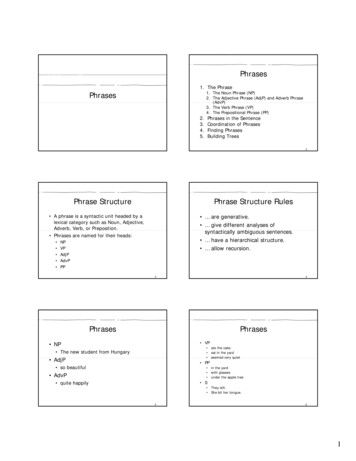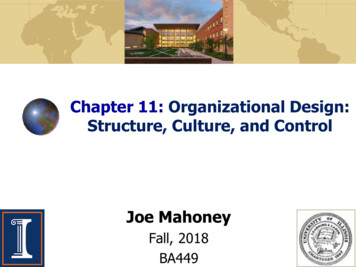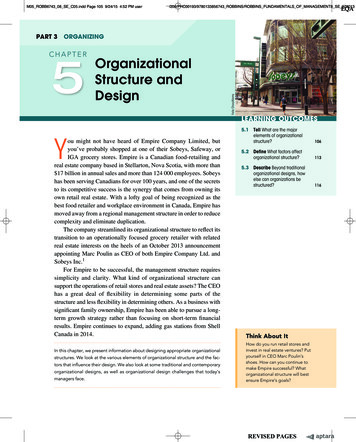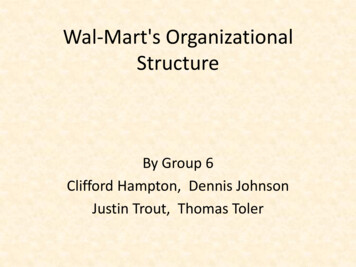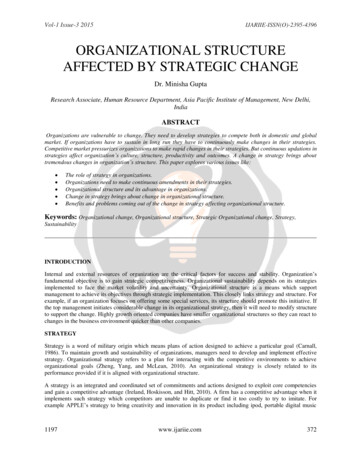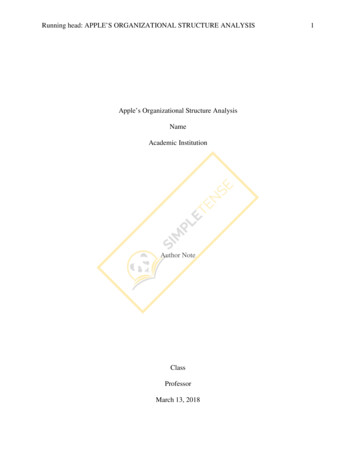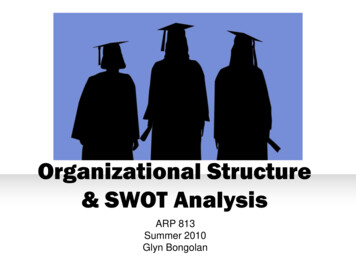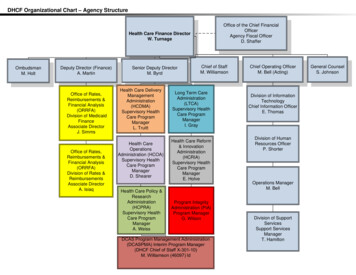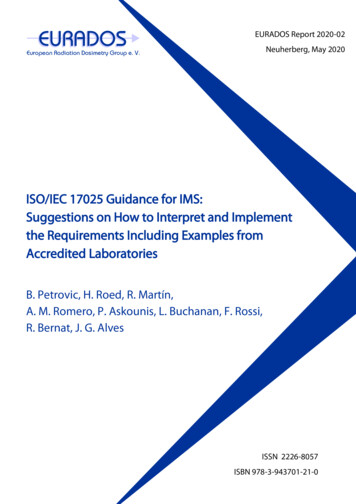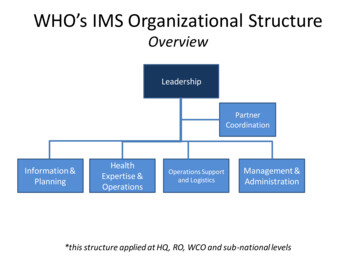
Transcription
WHO’s IMS Organizational rmation &PlanningHealthExpertise &OperationsOperations Supportand LogisticsManagement &Administration*this structure applied at HQ, RO, WCO and sub-national levels
WHO’s IMS Organizational StructureOverviewHeadquartersRegional OfficeCountry Office
WHO’s IMS Organizational StructureDetail, Level 3Staff Wellbeing and SecurityLeadershipExternal RelationsPartnerCoordinationHealth Partner Coord.EOC ManagementInformation &PlanningData Coll, Risk Anal,& Needs Assmnt.Information Products& DisseminationStrategic Response &Operations PlanningMonitoring &EvaluationProject ManagementLiaisonHealthExpertise &OperationsRisk comms/ comm engOperationsSupport &LogisticsSupply Chain MgmntEWARN & SurveillanceManagement &AdministrationFinance, Budget &Grant MgmntField SupportHealth Services DeliveryPrevention & ControlMeasuresScience & ResearchProcurementHealth LogisticsHR & Surge
Function and Sub-functionDefinitions
IMS Organization for ResponseFunctionsLeadershipPartner CoordinationInformation and PlanningHealth OperationsOperations Support and LogisticsManagement and administrationSub-FunctionsStrategic leadership and incident managementStaff health, wellbeing and securityExternal relations (Resource mob, Communications, Advocacy)EOC managementHealth partner coordinationLiaisonRisk analysis and needs assessmentInformation products and disseminationStrategic response and operations planningMonitoringProject managementRisk communications and community engagementEarly warning and surveillanceHealth service deliveryPrevention and control measures(case management, vector control, prep of unaffected areas)Science and researchSupply chain managementField support (ITC, transport, lodging, office)Health logisticsFinance, budget and grant managementProcurementHuman resources and surge
LeadershipIMS Organization for ResponseLeadership definitions, part 1Provides strategic leadership to thehealth sector/cluster response insupport of national and local healthauthorities--prioritizing filling healthservice delivery gaps to reach healthsector performance standards;manages the WHO response and thephysical emergency operations centrefrom which the WHO response teamworks-- ensuring fulfilment of WHO’ssix critical functions; based onrecommendations from theInformation and Planning function,determines WHO response teamstaffing needs and ensures that theAdministration and Finance functionmobilizing the human resourcesrequired; builds external relations—issuing communications and advocacyproducts and statements andmobilizing the necessary resourcesfor WHO and encouraging donors tofund the overall health sectorresponse to affected populations; andtracks security issues and takesconcrete measures to ensure thesafety and well-being of all those inWHO’s response teamStrategic leadership andincident managementExternal relations(Resource mobilisation,Communications andAdvocacy)Works with health authorities to steer priorities forthe health response; serves as overall manager ofWHO’s response team and supervises all functionalarea leads; provides overall direction to the healthcluster when activatedCoordinates with donors and members States in orderto support the implementation of the WHO strategicresponse and preparedness plan. It takes the lead inthe overall and day-to-day activities related toMobilization of resources such as fundingcontribution, in kind and in services; it manages thedaily communication and liaison with donorcommunities and partners; liaises on resourceMobilization at country, regional or global level;manages the donor advocacy materials; representsthe WHO response team at donor coordinationmeetings; in close coordination with project and grantmanagement, monitors and tracks the affectedcountries in terms of their funding needs and gaps;takes the lead in donor negotiations including a rapiddonor agreements negotiations and correspondence;liaises with other UN agencies in the context of thecoordinated UN wide range resource Mobilization.
IMS Organization for ResponseLeadership definitions, part 2EOC managementLeadershipContinued Staff health, wellbeing andsecurityThe EOC facility manager (not Incident Manager) isresponsible for the operation and maintenance ofEOC, to ensure that all of the EOC’s functionality,systems, hardware, software and staff support toolsare well-maintained and operational when needed,and that designated EOC personnel have access totraining to support their effectiveness. A larger,permanent facility will usually have a designated teamof technical personnel working with the EOC facilitymanager and providing information management,telecommunications support, geospatial informationsystems and security management. The EOC Managerorganizes visitors, provides briefings for new staff andacts as a resource for the Incident Manager, asneeded.The duty of care of staff to maintain health , wellbeing, security and safety of staff in developing anddeploying appropriate risk management approachesto protect people from possible harm.
IMS Organization for ResponsePartner Coordination definitionsPartner CoordinationHealth partnercoordinationFills health service delivery gaps in a prioritizedmanner by mapping existing capacities andproposing deployment of flexible service providersto priority locations; promotes collective actionand collective results from all health actors,including those deployed as part of the WHOresponse team (staff, consultants, GOARNmembers, or Stand By Partners) and thosedeployed otherwise (independent governmentaland non-governmental agencies within andoutside the health cluster and Emergency MedicalTeams); facilitates health partner involvement inhealth sector assessments, planning, information,interventions, monitoring and quality assurance;produces and continually updates a mapping ofwho is doing what where in health; both informsand is guided by the strategic priorities set by theleadership function together with national andlocal authorities.LiaisonFills health service delivery gaps in a prioritizedmanner by mapping existing capacities andproposing deployment of flexible service providersto priority locations; promotes collective action andcollective results from all health actors, includingthose deployed as part of the WHO response team(staff, consultants, GOARN members, or Stand ByPartners) and those deployed otherwise(independent governmental and non-governmentalagencies within and outside the health cluster andEmergency Medical Teams); facilitates healthpartner involvement in health sector assessments,planning, information, interventions, monitoring andquality assurance; produces and continually mapswho is doing what where in health; both informsand is guided by the strategic priorities set by theleadership function together with national and localauthorities; is represented at all HumanitarianCountry Team meetings with a representative fromthe Leadership Function; is represented at alltechnical-level inter-sectoral and inter-clustermeetings.To provide the point of contact for representativesof assisting and cooperating agencies and torespond to requests or concerns from non healthstakeholder groups. The LO address interorganizational issues. Bring issues and concerns tothe attention of the Incident Manager with arecommended course-of-action. Key goals include:to develop rosters of participating responseagencies with Coordination Function and otherstakeholders Facilitation information exchangewithin the EOC Exchange information with agencyreps/stakeholders
Information and PlanningIMS Organization for ResponseInformation and Planning definitions, part ICollects, analyses anddisseminates information onhealth risks, trends, needs,service delivery gaps, the resultsof interventions, andperformance; uses availableinformation to develop andcontinually refine acomprehensive health sectorresponse strategy and jointoperational plan, including WHO’sown operational response plan,with common healthsector/cluster indicators drawingon input from all functional leads,with consideration for logisticsconstraints; develops WHOproject documents based on theoverall strategy and plan, for useby the leadership function tomobilize resources; recommendsto the Leadership Function thehuman resource needs for WHO’sresponse team; continuallyadapts planning and projectdocuments as required based onavailable information; overseesthe implementation of WHOprojects and grants, ensuring thatimplementation, expenditure andreporting are consistent withplans and projects.Risk analysis andneeds assessmentInformation productsand disseminationRisk assessment is the process by which risks are identified,exposures are assessed and risks are characterised. This isconsolidated through the collection, analyse andinterpretation of all information related to an event. Thisallows stakeholders to make the best possible decisions(and take the best possible actions) with the informationavailable, and aims to prevent or reduce the impact of theevent. This assessment is an iterative process that guidesthe response.Needs assessment is the systematic process for determiningand addressing gaps between current conditions anddesired conditions, or between ‘needs’ and ‘wants’.This refers to the processing of data and communication ofinformation in a timely manner. It is based on needs/riskassessments, and involves compiling of information toproduce products appropriately tailored to their audience,in order to allow stakeholders to take appropriate actions.This can include internal and external situation reports(SitReps), bulletins, health risk assessments, health needsoverviews (HNO), and strategic response plans (SRP). It alsoinvolves communicating with, and being held accountableto, the people affected, the public, the media, memberstates, partners and donors. Communication with other IHRnational focal points.It also includes event specific information (what, where,who, how many, how quickly, current status), eventmanagement information (human and material resources,resource deployments, expenditure, status of interventionsand partner activities, progress towards achievingobjectives) and context data (mapping, populationdistribution, transport links, location of fixed and temporaryfacilities, clean water availability, climate and weather etc.)
IMS Organization for ResponseInformation and Planning definitions, part 2Information and PlanningContinued Strategic response andoperations planningMonitoringProject managementThe strategic response plan is a management toolthat guides the international response to a healthemergency by informing emergency responseorganizational planning and activities. It also servesas a roadmap for response organizations toprioritise activities and design projects.The WHO operational plan outlines the activitiesand resources (staffing, equipment, funding)required for the WHO to perform its role as thelead technical agency in health emergencies, andmore specifically as the leader of the Health Clusterin humanitarian emergencies and outbreaks.Systematically tracks the evolution of the incident,as well as the response, within the defined strategy.This involves defining the indicators and source(s)of information, gathering the data, interpreting thisdata, making a judgment about whether theresponse is on track, and if the response is not ontrack, analysing the reason(s) why.Working closely with the information and whilstremaining accountable, project managementsupports the design, structure and content of donorupdates and other reports; monitors projectimplementation and advises WCOs on how toadapt standard monitoring tools to the countrycontext; promotes standardized managementthroughout the project management cycle bydeveloping and disseminating guidelines andtemplates.
Health Expertise & OperationsIMS Organization for ResponseHealth Expertise & Operations definitions, Part 1Adapts and promotes technicalguidelines; trains health careproviders to improve quality ofservices; advises healthauthorities and partners on,and contributes to, theimplementation andstrengthening of healthsurveillance and early warningsystems; advises healthauthorities and partners on,and contributes to, theimplementation of controlmeasures; conductsoperational research toenhance interventions anddevelop content for riskcommunications; develops anddisseminates public health riskcommunications messages; andprovides patient care includingmedicines and supplies to fillservice delivery gaps, ifnecessary, as Provider of LastResort. The above may belimited to technical guidance,research and training, but mayalso extend to include fieldimplementationRisk communications &community engagementEarly warning &surveillanceDefine the content of key messages that are to becommunicated to population at risk for the prevention,mitigation and control to ensure that these messagesare technically sounds and appropriate to prevent,mitigate and control risks. As a provider of last resort,WHO may also ensure that these messages areappropriately communicate to target population andaudience.Develop or strengthen the system that ensures therapid collection, analysis, verification anddissemination of data related to the incidence ofepidemic prone diseases in all areas directly andindirectly affected by the emergency. Establish orstrengthened rapid response teams that areresponsible for the rapid investigation of alerts and theearly response to outbreaks.
IMS Organization for ResponseHealth Expertise & Operations definitions, Part 2Health Expertise & OperationsContinued Health servicedeliveryEnsure that health facilities serving the population affected by anemergency are equipped and provided with the necessaryinfrastructure, staff, information, equipment, drugs and medicalsupplies to address the existing and foreseen causes of excess morbidityand mortality affected by an emergency and to prevent thedissemination of infectious diseases within the facilities.Note: WHO only supports the delivery of health services as provider oflast resort.Prevention andcontrol measuresEnsure that all measures that can prevent and/or mitigate the risks toincreased morbidity and mortality are considered and instituted such asvaccination, vector control, water, sanitation and hygiene, increasednutritional intake.Note: WHO only supports the implementation of control measures asprovider of last resort. Includes case management, vector control, prepof unaffected countriesScience andresearchIdentify gaps in knowledge on the etiology, physiopathology,transmission, reliable and rapid diagnostic, effective prevention andtreatment of any of the causes of excess morbidity and mortality of thepopulation affected by the emergency, promotes and advise on relevantresearches necessary to address these gaps.
Operations Support and LogisticsIMS Organization for ResponseOperational support and logistics definitionsEnsures the transport, customs clearance,delivery, storage and management of materialassets for the response; establishes functionaloffices, housing and storage facilities asrequired; sets up telecommunications andother equipment for the smooth functioningof WHO’s response team at both national andsub-national levels as required; informsInformation and Planning function of logisticsconstraints that may hinder the work of otherFunctions.Alternate, from JC: the strategic managementand implementation of the tactical processesnecessary to support any WHO response inemergency situations resulting in or caused bypublic health events. Integrated across theorganization and consisting of establishedcomprehensive infrastructure, highly skilledprofessionals, and standardized processes,OSL provides the capacity for WHO tosuccessfully implement a rapid, fullyfunctional and efficient response to anyemergency crisis.Supply ChainmanagementField csEnsure an end to end, timely and efficient provisionof quality and adequate equipment andconsumables to support emergency responseoperations, aiming to reduce the consequences ofcrises on health systems and populations.Provides logistics strategy, management andoperations support, to response teams. Thisincludes functional and secure working spaces andequipment, communications capabilities, and safestaff transport and living accommodations as well aspartnerships and operational synergies to ensure aneffective management of a health crisis.Provides technical expertise, tools, methods andmeans in the areas of health emergency logisticsincluding; medical facilities & equipment, cold chainmanagement, Water Sanitation and Hygiene,Laboratory activity support .
Management & administrationIMS Organization for ResponseManagement and Administration definitionsProvidesmanagement andadministrativesupport to enablethe smoothfunctioning of theWHO response;ensuresleadership /incident managerdecisions triggerthe provision ofmanagement andadministrativeservices thatmeet emergencyperformancestandards.Finance, budget &grants managementProcurementHuman Resources andSurgeManages funding allocations and awards; tracks andreports on financing against budget; supports, monitorsand reports on financial implementation; monitors andfollows-up on donor proposal and reporting deadlines;supports in the preparation of proposals and reports forresource mobilization group; ensures payments.Procures all necessary supplies for the response and forthe response team, tracks inventory, coordinates withlogistics and HR to provide supplies and equipment to thelocal response team.Fills human resource needs of the WHO response team, asdetermined by the Leadership function, including sourcing,recruitment, medical clearance, travel to the relevant dutystation, entry formalities, briefing and training, on-siteadministrative support, de-briefing and performanceevaluations. Tracks and reports on HR requirementsagainst plans, status of filled positions/vacancies.
WHOs IMS Organizational Structure Overview Leadership Information & Planning . systems, hardware, software and staff support tools are well-maintained and operational when needed, . drugs and medical supplies to address the existing and foreseen causes of excess morbidity and
